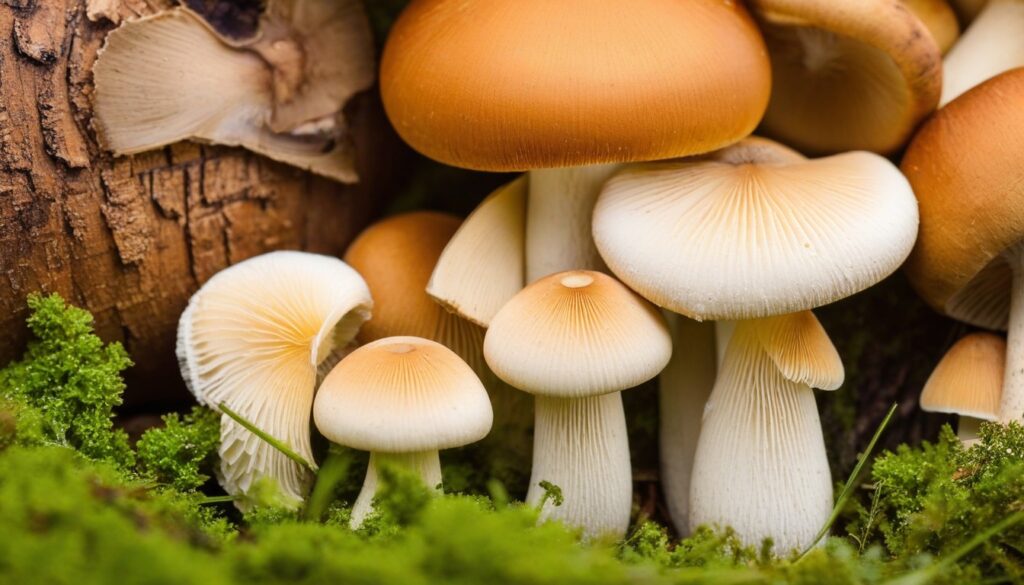Welcome to a flavorful adventure in the world of mushrooms! From the classic button mushroom to exotic varieties like shiitake, oyster, and portobello, mushrooms have been a beloved ingredient in cuisines around the world for centuries. Join me in celebrating the love for mushrooms and explore their diverse varieties, cooking styles, health benefits, and fascinating aspects.
Key Takeaways
- Mushrooms are a versatile ingredient with a wide range of culinary uses.
- They come in various sizes, shapes, colors, and flavors, making each variety unique.
- Mushrooms have potential health benefits, including boosting immunity and supporting heart health.
- They have a significant role in sustainable agriculture and food production.
- Foraging for mushrooms can be an enjoyable and rewarding activity with proper safety precautions.
The Magic of Mushrooms
Have you ever been amazed by the unique properties of mushrooms? These fascinating fungi have a charm of their own, with a world of magic waiting to be discovered.
Mushrooms have been used in traditional medicine for centuries due to their potential health benefits and medicinal properties. However, the scientific study of their properties is still in its infancy, and there is much that we don’t know about these mysterious organisms.
One of the most intriguing aspects of mushrooms is their growth pattern. Unlike plants, mushrooms don’t have chlorophyll and can’t produce their own food through photosynthesis. Instead, they grow by breaking down organic matter like dead leaves and wood, making them important decomposers in ecosystems.
In addition to their growth pattern, mushrooms have unique nutritional properties. They are low in calories and fat but rich in nutrients like vitamin D, niacin, potassium, and selenium. They also contain beta-glucans, a type of carbohydrate that may have immune-boosting effects.
Overall, mushrooms are a fascinating organism with many mysteries waiting to be uncovered. Whether you’re interested in their potential health benefits or simply enjoy their unique flavor and texture in cooking, there’s no denying the magic of mushrooms.
Exploring Mushroom Varieties
From the delicate white button mushrooms to meaty portobello caps and the earthy shiitake, mushrooms come in a plethora of varieties, each with its unique flavor profile and texture.
|
Mushroom Variety |
Flavor |
Texture |
|---|---|---|
|
Button Mushrooms |
Mild and subtle |
Firm and smooth |
|
Earthy and savory |
Meaty and chewy | |
|
Shiitake Mushrooms |
Earthy and smoky |
Firm and meaty |
|
Slightly sweet and delicate |
Fragile and velvety | |
|
Maitake Mushrooms |
Pungent and rich |
Firm and meaty |
Other popular mushroom varieties include enoki, crimini, chanterelle, and porcini. Each one adds a distinct flavor and texture to any dish.
When choosing mushrooms for a recipe, try to select fresh mushrooms that are firm and free of bruises. Different varieties are suited for various cooking methods, including sautéing, grilling, roasting, or even raw.
Experiment with different varieties of mushrooms to find your favorites and make your dishes stand out with unique and exciting flavors.
Cooking with Mushrooms: Exploring Delicious Mushroom Recipes
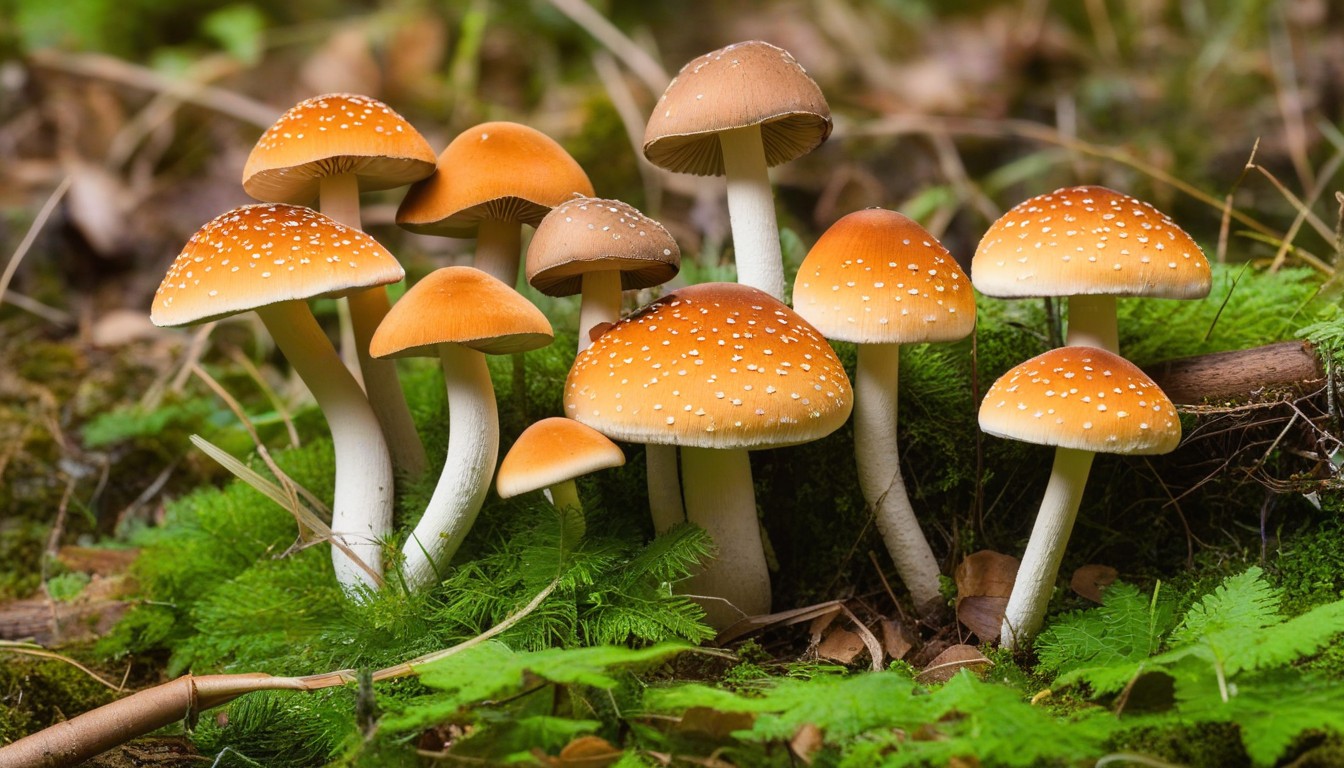
Mushrooms are incredibly versatile in the kitchen, and their unique flavors make them an excellent addition to a vast array of dishes. From simple sauteed mushrooms to more complex dishes like mushroom risotto, there are countless ways to use these delicious fungi in cooking.
Mushroom Saute
An easy but flavorful way to cook mushrooms is to saute them. Start by heating a pan over medium heat, adding butter or oil until melted. Then add sliced mushrooms and cook until they release their liquid and become tender. Season with salt, pepper, and any other spices you prefer. Serve as a side dish or a topping for grilled meats or sandwiches.
|
Mushroom Risotto |
Mushroom Stroganoff |
Mushroom Soup |
|---|---|---|
 |
 |
 |
|
A classic Italian dish, mushroom risotto features sauteed mushrooms mixed with creamy Arborio rice and Parmesan cheese. |
A hearty and comforting dish, mushroom stroganoff features sliced mushrooms in a rich and creamy sauce served over pasta or rice. |
A warm and comforting bowl of mushroom soup is perfect for a chilly day. Make it extra special by adding a dollop of sour cream or a drizzle of truffle oil on top. |
Mushroom and Spinach Frittata
A frittata is a perfect meal any time of day, and the addition of mushrooms and spinach makes it even more delicious and nutritious. Start by sauteing sliced mushrooms in olive oil until browned. Add chopped spinach and cook until wilted. Beat eggs in a bowl and add the mushroom and spinach mixture, along with shredded cheese and any other desired toppings. Cook in a skillet until set and golden brown on the bottom, then finish in the oven until the top is firm and cooked through.
- Creamy Mushroom Chicken
- Mushroom and Bacon Carbonara
- Grilled Portobello Mushroom Burger
- Mushroom and Gruyere Tart
These are just a few examples of the many ways to cook with mushrooms. Whether you are a seasoned home cook or a beginner in the kitchen, mushrooms offer endless possibilities for creating delicious and healthy meals that are sure to satisfy.
Health Benefits of Mushrooms
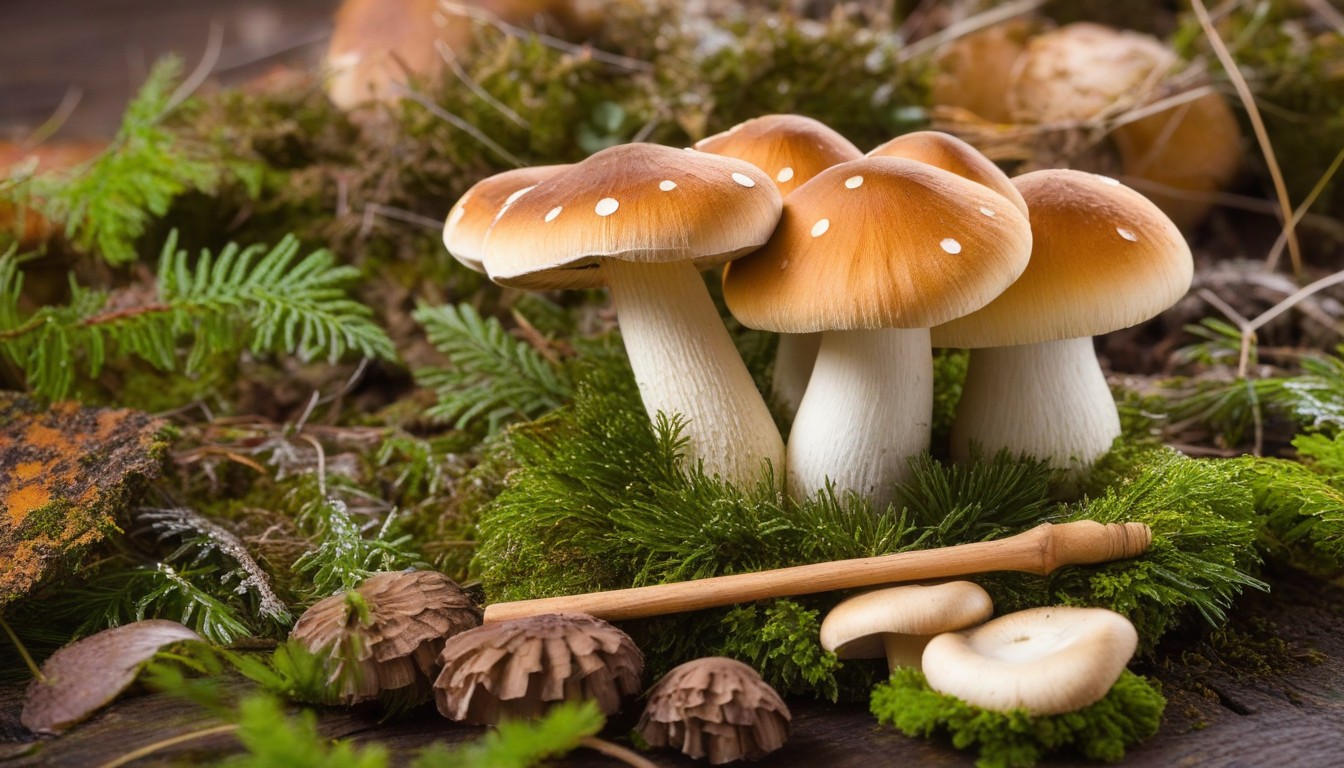
Mushrooms have been used for medicinal purposes for centuries, and for good reason. These fungi offer a wide range of health benefits, from boosting immunity to supporting heart health.
Immune System Boost
Mushrooms contain beta-glucans, which can activate the immune system and help it fight off infections and diseases.
Antioxidant Properties
Mushrooms contain antioxidants like selenium and ergothioneine, which protect the body from oxidative stress and reduce inflammation.
Heart Health
Mushrooms are low in calories, fat, and sodium, making them a heart-healthy food. They also contain compounds like beta-glucans and ergothioneine, which can help lower cholesterol levels and reduce the risk of heart disease.
Cancer-Fighting Properties
Some types of mushrooms, such as shiitake and maitake, contain compounds that have been shown to have anti-cancer properties. These compounds can help stop the growth and spread of cancer cells.
Vitamin D Source
Mushrooms are one of the few food sources of vitamin D, which is important for bone health and immune system function. Exposing mushrooms to sunlight or UV light can increase their vitamin D content even further.
With so many health benefits, it’s no wonder why mushrooms have been used for medicinal purposes for centuries. Incorporating them into your diet can help improve your overall well-being.
Mushrooms in Traditional Cuisine
From Italian pasta to Chinese stir-fries, mushrooms are a popular ingredient in traditional dishes from around the world. Let’s take a closer look at how different cultures incorporate these fungi into their culinary practices.
Italian Cuisine
In Italy, mushrooms are a staple in many dishes. One famous dish is risotto ai funghi, a creamy rice dish made with porcini mushrooms. Another popular recipe is tagliatelle ai funghi, a pasta dish with a creamy mushroom sauce. In Southern Italy, mushrooms are often used in pizza toppings, such as the classic pizza ai funghi with mozzarella and mushrooms.
French Cuisine
France is known for its rich and decadent cuisine, and mushrooms play a significant role in many French dishes. One example is coq au vin, a slow-cooked chicken stew with mushrooms and red wine. Another classic recipe is the creamy mushroom sauce served with steak. In French cuisine, mushrooms are often used to add depth and umami flavor to many dishes.
Chinese Cuisine
In China, mushrooms are believed to have medicinal properties and are used in many traditional dishes. The most commonly used mushrooms in Chinese cuisine are shiitake, wood ear, and reishi mushrooms. One popular dish is the stir-fried shiitake mushroom, which is often cooked with garlic and soy sauce. Another classic recipe is the hot and sour soup, which includes wood ear mushrooms as one of the main ingredients.
Indian Cuisine
In India, mushrooms are a relatively new ingredient in traditional cuisine but have gained popularity in recent years. One popular dish is the spicy mushroom masala, a curry made with mushrooms, onions, tomatoes, and a blend of spices. Another classic recipe is the mushroom biryani, a flavorful rice dish with mushrooms and aromatic spices.
These are just a few examples of how mushrooms are used in traditional cuisine around the world. With their unique and versatile flavor, it’s no wonder that mushrooms have been a part of culinary practices for centuries.
Foraging for Mushrooms
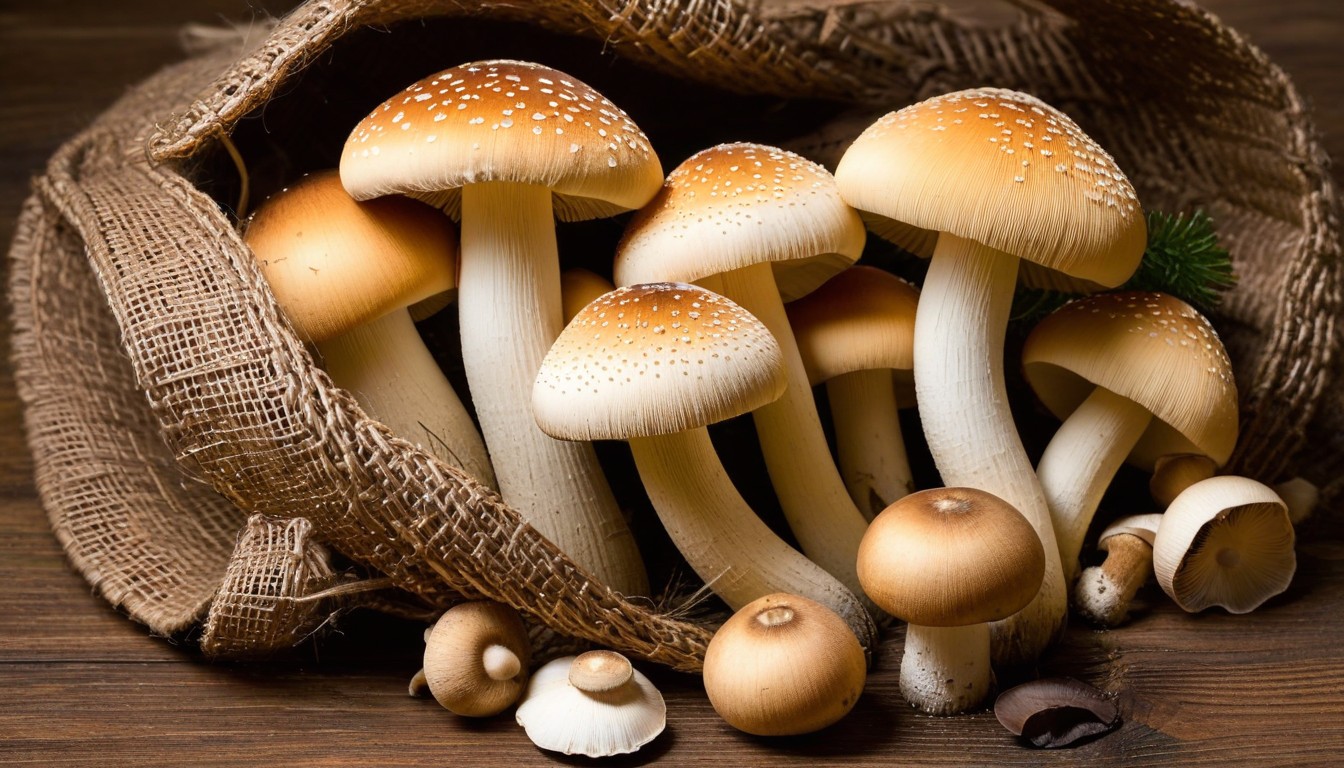
There’s something thrilling about finding and cooking with mushrooms sourced directly from the wild. But foraging for mushrooms requires knowledge, preparation, and safety precautions to avoid the risk of poisoning.
Foraging Safety Guidelines
The first rule of mushroom foraging is to be certain of what you’re picking. While most wild mushrooms are edible, there are also many poisonous varieties that can lead to serious illness or even death. It’s crucial to identify mushrooms accurately and never consume any that you’re unsure of.
Here are some general safety guidelines to follow when foraging for mushrooms:
- Research the area you plan to forage and only gather mushrooms from areas that are known to be safe and free from pollution
- Wear appropriate clothing, such as long pants and sleeves, to protect against ticks and other insects, as well as poison ivy and other plants that can cause skin irritation
- Use a field guide or take a foraging class to learn how to identify safe and edible mushrooms
- Always carry a basket or breathable bag to allow spores to continue to spread and never use plastic bags, which can cause mushrooms to spoil quickly
- Avoid foraging in areas with potential hazards, such as steep slopes, rocky terrain, or areas that are prone to flooding
Best Locations for Foraging
Mushrooms are found in various habitats, including forests, meadows, and even your own backyard. Some ideal locations for mushroom foraging include:
|
Location |
Best Time to Forage |
Common Mushroom Varieties Found |
|---|---|---|
|
Deciduous Forests |
Spring and Fall |
Morels, chanterelles, and oysters |
|
Coniferous Forests |
Late Summer and Fall | |
|
Fields and Meadows |
Summer and Fall |
Puffballs, meadow mushrooms, and fairy ring mushrooms |
Wild Mushroom Recipes
Once you’ve foraged your mushrooms safely, it’s time to cook them up and enjoy their distinct flavors. Here are some recipe ideas using wild mushrooms:
- Wild mushroom risotto
- Grilled wild mushroom skewers
- Wild mushroom quiche
- Wild mushroom and herb omelet
- Wild mushroom soup
Remember, foraging for mushrooms is a wonderful way to connect with nature and enjoy the unique flavors of wild-grown fungi. But always err on the side of caution and never consume any mushrooms that you’re not 100% certain are safe and edible.
The Science Behind Mushrooms
When it comes to understanding mushrooms, there is more than meets the eye. Mushrooms are technically classified as fungi, a separate group from plants and animals. They lack chlorophyll and rely on organic matter for nutrition.
Mushrooms are unique in their growth patterns, as they develop through a process called myceliation. This involves the formation of underground networks of tiny thread-like structures called mycelium that absorb nutrients from the soil. Once the mycelium has accumulated enough energy, it produces the visible fruiting body we commonly refer to as mushrooms.
The nutritional value of mushrooms varies based on the species, but overall, they are a good source of nutrients like vitamins B and D, potassium, and copper. Additionally, mushrooms contain bioactive compounds like polysaccharides and triterpenoids that have been associated with various health benefits.
Mushrooms are unique in their growth patterns, as they develop through a process called myceliation.
One of the interesting aspects of mushrooms is their ability to form symbiotic relationships with other organisms. For example, certain species of mushrooms are known to associate with trees, exchanging nutrients through their mycelial networks. This relationship is crucial for the health of both the mushrooms and trees, as it allows for the efficient transfer of nutrients throughout the ecosystem.
Mushrooms also play an important ecological role in decomposing organic matter. They break down complex molecules into simpler compounds, freeing up nutrients for other organisms to use. This makes mushrooms an essential component of nutrient cycling in terrestrial ecosystems.
Overall, the science behind mushrooms is fascinating and highlights the intricate relationships between different organisms in the natural world.
Mushroom Preservation Methods
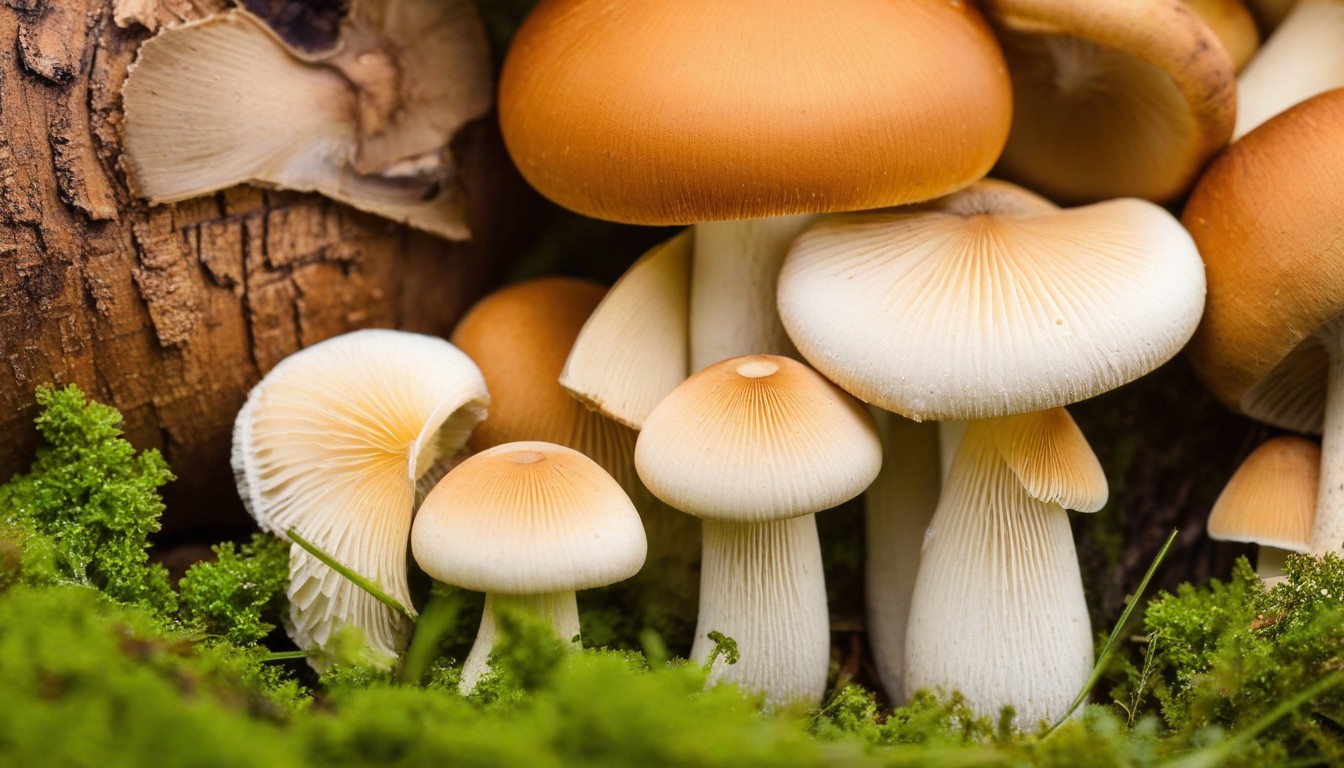
Mushrooms are a versatile and flavorful ingredient that can be used in a variety of dishes. However, they can be difficult to preserve due to their high water content and susceptibility to spoilage. Here are some mushroom preservation and storage methods that will help you enjoy these fungi for longer:
Drying
Drying is a popular method for preserving mushrooms. To dry mushrooms, clean them thoroughly and slice them into thin, even pieces. Place the mushroom slices on a baking sheet and dry them in an oven at a low temperature (around 150°F) until they are completely dried out. Alternatively, you can air-dry mushrooms by placing them in a warm, dry place until they are dehydrated. Once dried, store them in an airtight container in a cool, dry place.
Freezing
Freezing is another effective way to preserve mushrooms. To freeze mushrooms, clean them and slice them into desired sizes. Blanch them in boiling water for 1-2 minutes, then transfer them into ice water to stop the cooking process. Pat the mushrooms dry and place them into airtight freezer bags or containers. Frozen mushrooms can be stored for up to six months.
Pickling
Pickling mushrooms in vinegar is a great way to give them a tangy flavor and extend their shelf life. To pickle mushrooms, clean and slice them as desired. In a small saucepan, bring vinegar, water, salt, sugar, and desired spices to a boil. Once the liquid has cooled, add the mushrooms and let them soak for at least 24 hours before transferring them to a clean, airtight container. Store pickled mushrooms in the refrigerator for up to two months.
Canning
Canning mushrooms is a great way to preserve them for long-term storage. To can mushrooms, clean and slice them as desired. Pack the mushrooms into sterilized jars and cover them with boiling water, leaving 1 inch of headspace. Add 1/2 teaspoon salt to each pint jar, then seal the jars and process them in a pressure canner according to the manufacturer’s instructions.
By using these mushroom preservation and storage methods, you can enjoy your favorite fungi any time of year!
Mushrooms and Sustainability
Mushrooms are more than just a tasty addition to our meals. They also play a crucial role in sustainable agriculture and food production. Here’s how:
|
Mushrooms Promote Soil Health |
Mushrooms Reduce Waste |
|---|---|
|
Mushrooms have the ability to break down complex organic matter, like fallen leaves and other plant debris, into nutrients that can nourish soil and support plant growth. This process, known as decomposition, helps to maintain healthy soil ecosystems by creating a fertile environment for crops to thrive. |
In addition to breaking down organic matter, mushrooms can also be used to transform waste materials into valuable resources. For example, some mushroom species can be grown on agricultural waste products like straw, turning this “waste” into a valuable source of protein and other nutrients. |
This ability to recycle and transform organic matter makes mushrooms a valuable tool for sustainable agriculture and composting efforts.
Another sustainable aspect of mushroom farming is their low environmental impact. Compared to traditional livestock farming, mushroom production requires less land, water, and energy, making it a more sustainable and efficient use of resources. Additionally, the carbon footprint of mushroom cultivation is relatively low.
Finally, mushrooms can contribute to sustainable food systems by providing a plant-based source of protein. As the demand for meat-free and plant-based diets grows, mushrooms can play a vital role in meeting this need.
So next time you enjoy a delicious mushroom dish, remember the important role these fungi play in promoting sustainability in agriculture and food production.
Mushroom Trivia and Fun Facts
Did you know that mushrooms are not actually plants, but a type of fungi? Here are some more mushroom trivia and fun facts:
- World’s Largest Mushroom: The world’s largest living organism is a mushroom in Oregon’s Malheur National Forest, covering 2,200 acres!
- Historical Significance: Mushrooms have been used as food and medicine for thousands of years. Ancient Egyptians considered mushrooms to be the food of the gods and reserved them only for royalty.
- Musical Inspiration: The Beatles famously included a reference to a “mushroom” in their song “I Am the Walrus.”
- Mushrooms in Space: In 2021, NASA sent a batch of shiitake mushroom samples to the International Space Station to study how they grow and react to microgravity.
- Toxicity: Some mushrooms can be highly toxic and cause illness or even death if ingested. It’s important to have an expert identify any wild mushrooms you plan to eat.
- Namesake: The psychedelic drug LSD was derived from a compound found in a type of fungus called ergot.
- Mushroom Etymology: The word “mushroom” comes from the French word “champignon,” which means “mushroom” or “edible fungus.”
“Mushrooms are like little sponges that soak up the flavors of the ingredients they are cooked with.” – Chef Dan Barber
So there you have it – a few mushroom trivia and fun facts to impress your friends with at your next dinner party!
Conclusion
Congratulations on completing this culinary journey through the world of mushrooms. We hope you have enjoyed exploring their diverse varieties, unique properties, cooking styles, health benefits, and fascinating aspects.
As we conclude this article, we invite you to reflect on the love for mushrooms that we share. Whether you are a gourmet chef or a home cook, mushrooms offer endless possibilities for creative dishes that are both delicious and nutritious.
Remember to try out the various cooking techniques we have discussed, experiment with different varieties, and incorporate mushrooms into your diet for a boost in overall well-being. Not to mention, mushrooms can add a touch of magic to any dish!
Thank you for joining us on this flavorful adventure. We hope you have found it informative and engaging. Until next time, happy mushroom hunting!
FAQ
What are the different varieties of mushrooms?
There are numerous varieties of mushrooms, including button mushrooms, shiitake mushrooms, oyster mushrooms, and portobello mushrooms, among others.
How can I cook with mushrooms?
Mushrooms can be cooked using various techniques such as sautéing, roasting, grilling, or adding them to soups, sauces, and stews. They add depth and flavor to many dishes.
What are the health benefits of mushrooms?
Mushrooms are a nutritional powerhouse, rich in vitamins, minerals, and antioxidants. They are known to boost immunity, support heart health, and provide other potential health benefits.
How can I preserve mushrooms?
Mushrooms can be preserved through methods like drying, freezing, pickling, or canning. These methods help to extend their shelf life and ensure they can be enjoyed for longer.
Where can I find wild mushrooms?
Foraging for wild mushrooms should be done with caution and knowledge. Seek out local resources, follow safety guidelines, and consider joining foraging clubs or guided tours to find the best locations.
What is the ecological importance of mushrooms?
Mushrooms play a crucial role in ecosystems as decomposers, helping recycle organic matter and promoting soil health. They contribute to sustainable agriculture and reduce waste.
What are some fun facts about mushrooms?
Did you know that the largest living organism on Earth is a mushroom? Mushrooms also have fascinating growth patterns and have been used for centuries in various cultures for both culinary and medicinal purposes.

